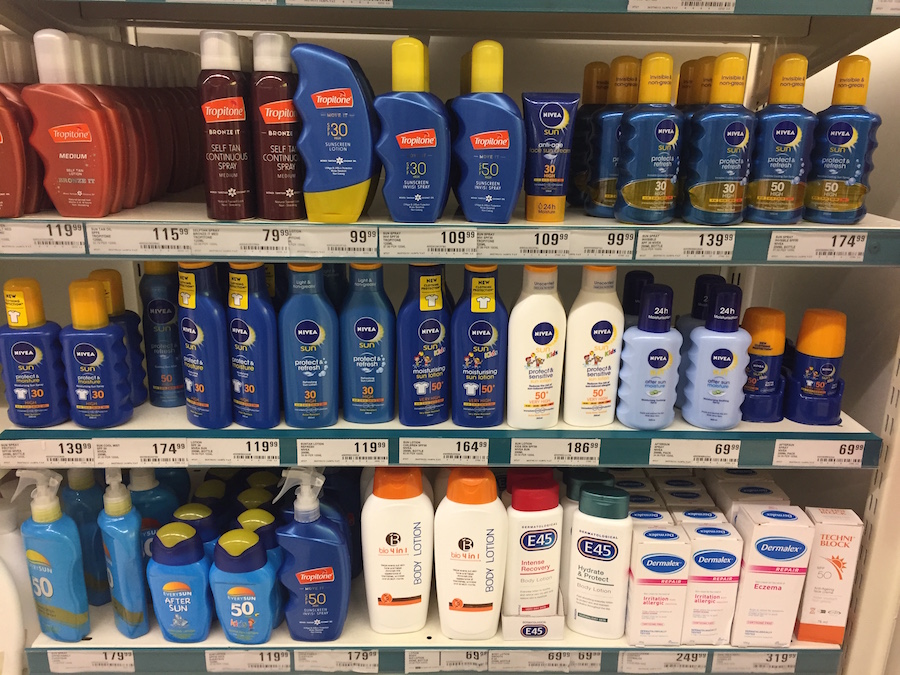As spring break and summer plans near, warm weather means we’ll spend more time in the sun. And here at PassportJoy, spending time outdoors is what we do best. But sun protection can be confusing. It can be hard to know where to start with so many products available. As a clinical pharmacist, I know the importance of sun protection.
It’s important to remember that applying sunscreen daily should be practiced throughout the year, including winter months, foggy, and cloudy days. When choosing a sunscreen, be sure to read the label before you buy the product. The Food and Drug Administration (FDA) requires the labels to follow specific regulations. However, understanding the labels can be difficult. Follow my guide below to help you understand the labels and the secret to choosing the right sunscreen.

“Broad-spectrum” Protection
When choosing a sunscreen, make sure to select a sunscreen with broad-spectrum protection. Sunscreens with this label protect against both UVA and UVB rays. UVA rays are the longer UV rays that contribute to premature aging and skin cancers. UVB rays are the shorter UV rays that cause sunburn in addition to skin cancers. All sunscreen products protect against UVB rays.
Sun Protection Factor (SPF)
According to the American Cancer Society, when choosing sunscreen, make sure you select a sunscreen with a sun protection factor (SPF)of 30 or higher. Sunscreens below SPF 15 will only protect against sunburn, not skin cancers or premature skin aging. The SPF number indicates the level of protection the sunscreen will provide against the UVB rays that cause sunburn and skin cancer. Although higher SPF numbers do offer more protection against UVB rays, the difference is minimal.
According to the American Cancer Society, SPF 15 sunscreens filter out 93% of UVB rays. SPF 30 sunscreens filter out 97% of UVB rays, SPF 50 sunscreens filter out 98%, and SPF 100 sunscreens filter out 99%. Unfortunately, there is no sunscreen available on the market that will filter out 100% UVB rays.
Applying Sunscreen
Apply 30 minutes before going outside in the sun to allow the skin time to absorb the sunscreen. The average adult needs at least one fluid ounce (2 tablespoons) of sunscreen for complete coverage.
Reapplying Sunscreen
Reapply at least every two hours outdoors and immediately after swimming or heavy sweating. It’s easily broken down over time by the sun and rubbed off by water, sweat, and towels.
“Water-resistant” Label
There’s no sunscreens that are “waterproof” or “sweatproof.” Sunscreen manufacturers must label their products to specify how long their effect lasts while swimming or sweating so you’ll know when to reapply. To be safe, reapply sunscreen more often during swimming or sweating and at least every 2 hours when outdoors.
Should Everyone Use Sunscreen?
The answer is yes. Although people with darker complexions are not at as high a risk of developing skin cancers as those with lighter complexions, everyone has some risk of developing skin cancer.
Using Multiple Products with SPF
As a clinical pharmacist, I often get asked the order to apply skin care products for optimal use. A common question is how to use sunscreen with topical prescription medications (acne medications, topical steroids, topical antibiotics, hormone replacement therapy, etc.). Topical prescription medications should be applied first, directly to the skin, followed by moisturizer, sunscreen, then makeup (if applicable). There are daily moisturizers and makeup that contain SPF. Make sure to select products that have an SPF of 30 or higher if you do not intend to apply additional sunscreen.
Medications and Sunscreen
Photosensitivity or sun sensitivity is inflammation of the skin caused by exposure to sunlight and certain medications. Phototoxicity can result when a person uses a photosensitizing product (a medication) and is exposed to ultraviolet radiation (UVR) from the sun. The result is a severe sunburn that can occur within minutes to hours after sun exposure. A phototoxic reaction typically clears up once the drug is discontinued and the medication is cleared from the body.
Photoallergic reactions occur when UV exposure changes the drug’s chemical structure (mostly topical drugs), causing the body’s immune system to see the drug as a foreign invader. As a result, the body’s immune system initiates an allergic response causing inflammation to sun-exposed areas of the skin. The rash can occur 1 to 3 days after taking the medication, is long-lasting, can spread, and may return after the drug is discontinued and cleared from the body.
Prevention is the best way to handle photosensitivity; wearing sunscreen is a must.




Leave a Reply